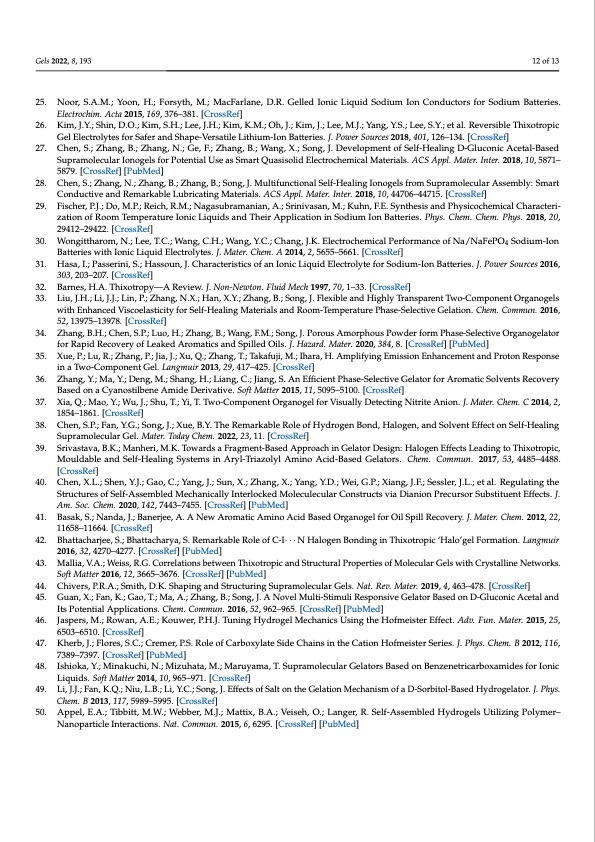
PDF Publication Title:
Text from PDF Page: 012
Gels 2022, 8, 193 12 of 13 25. Noor, S.A.M.; Yoon, H.; Forsyth, M.; MacFarlane, D.R. Gelled Ionic Liquid Sodium Ion Conductors for Sodium Batteries. Electrochim. Acta 2015, 169, 376–381. [CrossRef] 26. Kim, J.Y.; Shin, D.O.; Kim, S.H.; Lee, J.H.; Kim, K.M.; Oh, J.; Kim, J.; Lee, M.J.; Yang, Y.S.; Lee, S.Y.; et al. Reversible Thixotropic Gel Electrolytes for Safer and Shape-Versatile Lithium-Ion Batteries. J. Power Sources 2018, 401, 126–134. [CrossRef] 27. Chen, S.; Zhang, B.; Zhang, N.; Ge, F.; Zhang, B.; Wang, X.; Song, J. Development of Self-Healing D-Gluconic Acetal-Based Supramolecular Ionogels for Potential Use as Smart Quasisolid Electrochemical Materials. ACS Appl. Mater. Inter. 2018, 10, 5871– 5879. [CrossRef] [PubMed] 28. Chen, S.; Zhang, N.; Zhang, B.; Zhang, B.; Song, J. Multifunctional Self-Healing Ionogels from Supramolecular Assembly: Smart Conductive and Remarkable Lubricating Materials. ACS Appl. Mater. Inter. 2018, 10, 44706–44715. [CrossRef] 29. Fischer, P.J.; Do, M.P.; Reich, R.M.; Nagasubramanian, A.; Srinivasan, M.; Kuhn, F.E. Synthesis and Physicochemical Characteri- zation of Room Temperature Ionic Liquids and Their Application in Sodium Ion Batteries. Phys. Chem. Chem. Phys. 2018, 20, 29412–29422. [CrossRef] 30. Wongittharom, N.; Lee, T.C.; Wang, C.H.; Wang, Y.C.; Chang, J.K. Electrochemical Performance of Na/NaFePO4 Sodium-Ion Batteries with Ionic Liquid Electrolytes. J. Mater. Chem. A 2014, 2, 5655–5661. [CrossRef] 31. Hasa, I.; Passerini, S.; Hassoun, J. Characteristics of an Ionic Liquid Electrolyte for Sodium-Ion Batteries. J. Power Sources 2016, 303, 203–207. [CrossRef] 32. Barnes, H.A. Thixotropy—A Review. J. Non-Newton. Fluid Mech 1997, 70, 1–33. [CrossRef] 33. Liu, J.H.; Li, J.J.; Lin, P.; Zhang, N.X.; Han, X.Y.; Zhang, B.; Song, J. Flexible and Highly Transparent Two-Component Organogels with Enhanced Viscoelasticity for Self-Healing Materials and Room-Temperature Phase-Selective Gelation. Chem. Commun. 2016, 52, 13975–13978. [CrossRef] 34. Zhang, B.H.; Chen, S.P.; Luo, H.; Zhang, B.; Wang, F.M.; Song, J. Porous Amorphous Powder form Phase-Selective Organogelator for Rapid Recovery of Leaked Aromatics and Spilled Oils. J. Hazard. Mater. 2020, 384, 8. [CrossRef] [PubMed] 35. Xue, P.; Lu, R.; Zhang, P.; Jia, J.; Xu, Q.; Zhang, T.; Takafuji, M.; Ihara, H. Amplifying Emission Enhancement and Proton Response in a Two-Component Gel. Langmuir 2013, 29, 417–425. [CrossRef] 36. Zhang, Y.; Ma, Y.; Deng, M.; Shang, H.; Liang, C.; Jiang, S. An Efficient Phase-Selective Gelator for Aromatic Solvents Recovery Based on a Cyanostilbene Amide Derivative. Soft Matter 2015, 11, 5095–5100. [CrossRef] 37. Xia, Q.; Mao, Y.; Wu, J.; Shu, T.; Yi, T. Two-Component Organogel for Visually Detecting Nitrite Anion. J. Mater. Chem. C 2014, 2, 1854–1861. [CrossRef] 38. Chen, S.P.; Fan, Y.G.; Song, J.; Xue, B.Y. The Remarkable Role of Hydrogen Bond, Halogen, and Solvent Effect on Self-Healing Supramolecular Gel. Mater. Today Chem. 2022, 23, 11. [CrossRef] 39. Srivastava, B.K.; Manheri, M.K. Towards a Fragment-Based Approach in Gelator Design: Halogen Effects Leading to Thixotropic, Mouldable and Self-Healing Systems in Aryl-Triazolyl Amino Acid-Based Gelators. Chem. Commun. 2017, 53, 4485–4488. [CrossRef] 40. Chen, X.L.; Shen, Y.J.; Gao, C.; Yang, J.; Sun, X.; Zhang, X.; Yang, Y.D.; Wei, G.P.; Xiang, J.F.; Sessler, J.L.; et al. Regulating the Structures of Self-Assembled Mechanically Interlocked Moleculecular Constructs via Dianion Precursor Substituent Effects. J. Am. Soc. Chem. 2020, 142, 7443–7455. [CrossRef] [PubMed] 41. Basak, S.; Nanda, J.; Banerjee, A. A New Aromatic Amino Acid Based Organogel for Oil Spill Recovery. J. Mater. Chem. 2012, 22, 11658–11664. [CrossRef] 42. Bhattacharjee, S.; Bhattacharya, S. Remarkable Role of C-I· · · N Halogen Bonding in Thixotropic ‘Halo’gel Formation. Langmuir 2016, 32, 4270–4277. [CrossRef] [PubMed] 43. Mallia, V.A.; Weiss, R.G. Correlations between Thixotropic and Structural Properties of Molecular Gels with Crystalline Networks. Soft Matter 2016, 12, 3665–3676. [CrossRef] [PubMed] 44. Chivers, P.R.A.; Smith, D.K. Shaping and Structuring Supramolecular Gels. Nat. Rev. Mater. 2019, 4, 463–478. [CrossRef] 45. Guan, X.; Fan, K.; Gao, T.; Ma, A.; Zhang, B.; Song, J. A Novel Multi-Stimuli Responsive Gelator Based on D-Gluconic Acetal and Its Potential Applications. Chem. Commun. 2016, 52, 962–965. [CrossRef] [PubMed] 46. Jaspers, M.; Rowan, A.E.; Kouwer, P.H.J. Tuning Hydrogel Mechanics Using the Hofmeister Effect. Adv. Fun. Mater. 2015, 25, 6503–6510. [CrossRef] 47. Kherb, J.; Flores, S.C.; Cremer, P.S. Role of Carboxylate Side Chains in the Cation Hofmeister Series. J. Phys. Chem. B 2012, 116, 7389–7397. [CrossRef] [PubMed] 48. Ishioka, Y.; Minakuchi, N.; Mizuhata, M.; Maruyama, T. Supramolecular Gelators Based on Benzenetricarboxamides for Ionic Liquids. Soft Matter 2014, 10, 965–971. [CrossRef] 49. Li, J.J.; Fan, K.Q.; Niu, L.B.; Li, Y.C.; Song, J. Effects of Salt on the Gelation Mechanism of a D-Sorbitol-Based Hydrogelator. J. Phys. Chem. B 2013, 117, 5989–5995. [CrossRef] 50. Appel, E.A.; Tibbitt, M.W.; Webber, M.J.; Mattix, B.A.; Veiseh, O.; Langer, R. Self-Assembled Hydrogels Utilizing Polymer– Nanoparticle Interactions. Nat. Commun. 2015, 6, 6295. [CrossRef] [PubMed]PDF Image | Thixotropic Ionogel Electrolyte for Sodium Batteries

PDF Search Title:
Thixotropic Ionogel Electrolyte for Sodium BatteriesOriginal File Name Searched:
gels-08-00193-v2.pdfDIY PDF Search: Google It | Yahoo | Bing
Product and Development Focus for Salgenx
Redox Flow Battery Technology: With the advent of the new USA tax credits for producing and selling batteries ($35/kW) we are focussing on a simple flow battery using shipping containers as the modular electrolyte storage units with tax credits up to $140,000 per system. Our main focus is on the salt battery. This battery can be used for both thermal and electrical storage applications. We call it the Cogeneration Battery or Cogen Battery. One project is converting salt (brine) based water conditioners to simultaneously produce power. In addition, there are many opportunities to extract Lithium from brine (salt lakes, groundwater, and producer water).Salt water or brine are huge sources for lithium. Most of the worlds lithium is acquired from a brine source. It's even in seawater in a low concentration. Brine is also a byproduct of huge powerplants, which can now use that as an electrolyte and a huge flow battery (which allows storage at the source).We welcome any business and equipment inquiries, as well as licensing our flow battery manufacturing.| CONTACT TEL: 608-238-6001 Email: greg@salgenx.com | RSS | AMP |